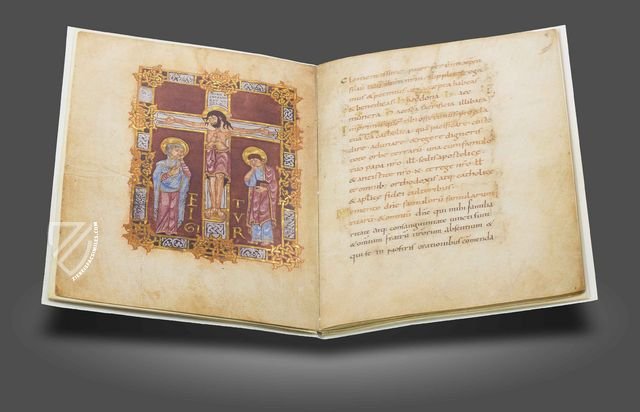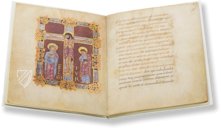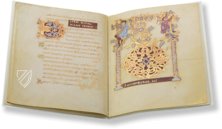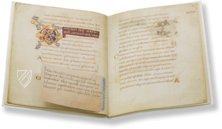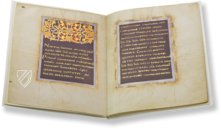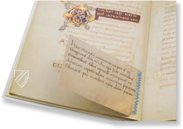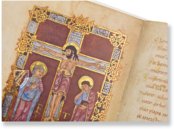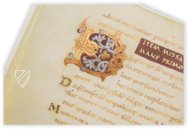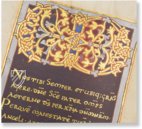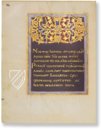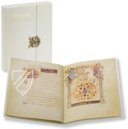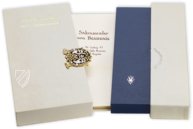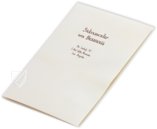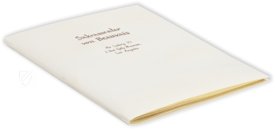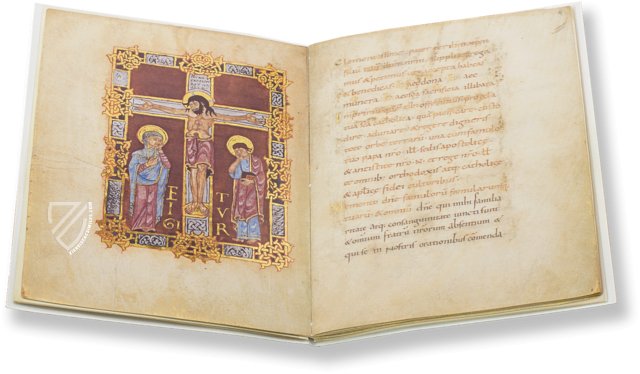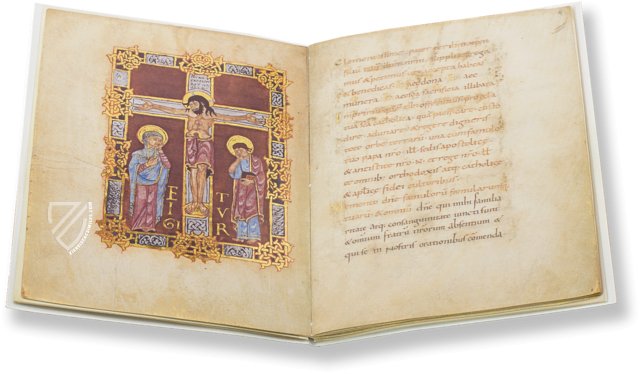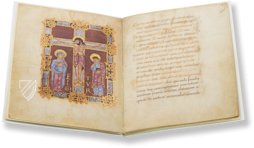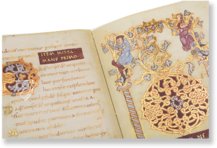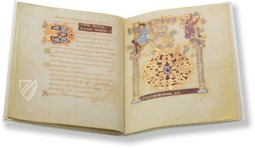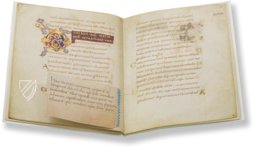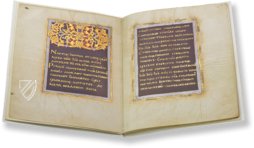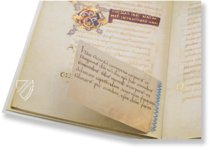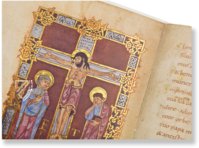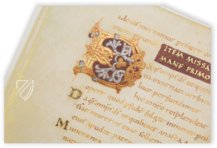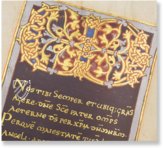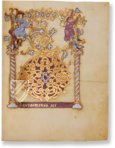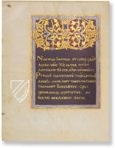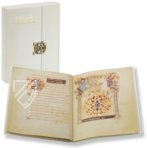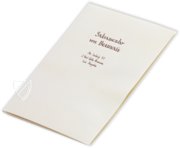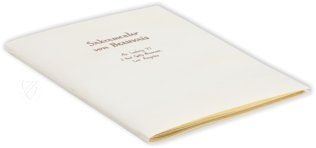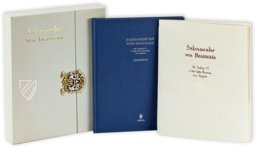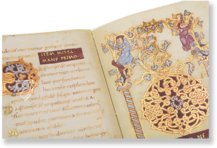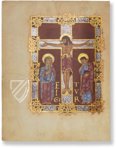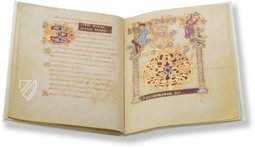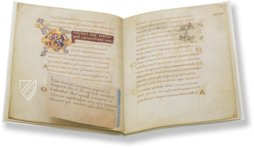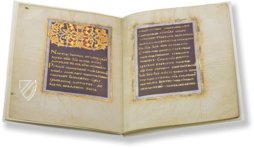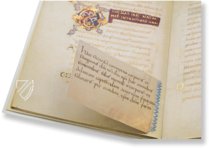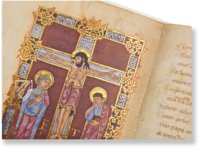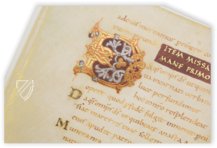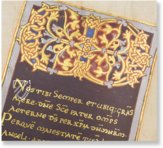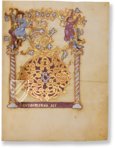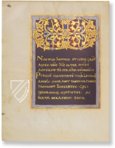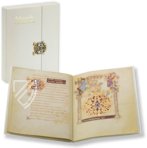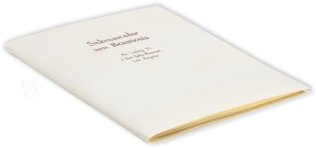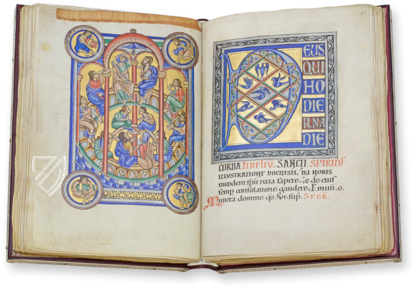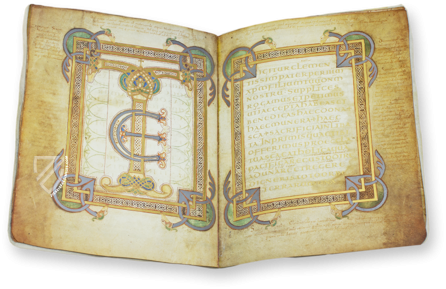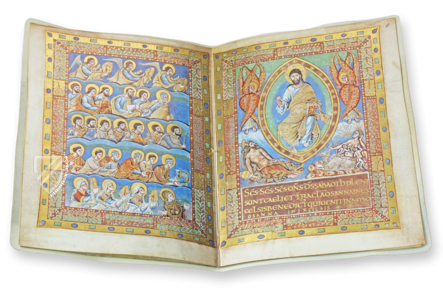Sacramentary of Beauvais
(1,000€ - 3,000€)
The transmission of contemporary witnesses so rich in history, as medieval codices are, sometimes goes its own way. Thus, only 10 fine pages of this sacramentary of Beauvais, decorated with a particularly large amount of gold and silver, have survived today. Three of them are written in gold script on a purple background. The reason for the loss of the remaining pages was the greed for profit of a bookseller in the early 19th century, who cut up the precious manuscript in order to be able to make a higher profit by selling the individual lots. When Prince-Bishop Roger of Champagne (d. 1016), Bishop of Beauvais, commissioned the Sacramentary, it did not contain the priest's mass texts for the entire church year, but only those for special occasions; Easter, Christmas, and Ascension Day are among the pages still preserved today, which explains the particularly sumptuous decoration of the pages.
Sacramentary of Beauvais
The Sacramentary of Beauvais in the collection of the J. Paul Getty Museum in Los Angeles (Ms. Ludwig V 1) is one of a pair of lavish liturgical manuscripts almost certainly produced in northern France by an Italian scribe, who also may have illuminated the volumes. Only ten leaves of the original book have survived into modern times, those leaves are clearly preserved because of their beauty and the generous use of gold and – more remarkably – silver. Included among the surviving leaves are three pages of text written in gold on painted purple grounds, a stunning full-page Crucifixion scene, and a nearly full-page initial in gold and silver, as well as smaller painted initials. The complete manuscript was known to the seventeenth-century canons of Beauvais cathedral as the “Missal of Roger of Champagne,” and indeed, the sacramentary most probably was created at the behest of Roger of Champagne (d. 1016), the first count-bishop of Beauvais, who was named in an inscription on an early binding. Roger was renowned for having endowed the cathedral with precious goods, including the sacramentary and two other sumptuous liturgical books.
The Sacramentary – A Book of Prayers for the Holy Mass
A sacramentary contains the prayers given by the celebrating priest at mass. The Sacramentary of Beauvais preserves all of the Eucharistic prayers, which are invariable throughout the liturgical year. Among the various prayers on the surviving pages are those for two Christmas masses, Easter and Ascension. The manuscript, which never had a full series of Sunday prayers, was clearly a book for special occasions, and the addition of the names of Saints Quentin and Cassien to one of the prayers suggests that one of the special occasions was the consecration in 1069 of the church of the Augustinian monastery of Saint-Quentin de Beauvais, founded by Guy, bishop of Beauvais, in 1067.
A Masterly Work
The gifted illuminator of the Beauvais Sacramentary, working in paints of precious metals as well as more traditional pigments, was skilled both in the intricacies of sophisticated interlace and in the convincing depiction of the human figure. The interlace on the Crucifixion page and the interlace of the letter "D" for Easter are each composed of three separate strands of strap work. On the Crucifixion page, a single, continuous strand defines the cross, and two others comprise the frame, all interlocking into a cohesive whole. Exuberant though the interlace may be, it does not detract from the focus on Christ’s role in salvation history and the artist has masterfully conveyed both the human figure, especially in the musculature of Christ’s torso, and the pathos of the event.
An Italian Scribe in France
The work of the scribe of the Beauvais Sacramentary can be found in a French Gospel lectionary, written according to its dedicatory inscription, by a scribe “from Italy, which surpasses all realms of intellectual brilliance” (Paris, Bibliothèque nationale de France, MS lat. 1126). Aspects of his writing also show a familiarity with Milanese conventions. Meanwhile, both the wonderful illumination and the masterly text have been attributed to the illuminator Nivardus of Milan. He was active around 1000 and initially illuminated manuscripts for the Bishop of Milan before he was summoned to the Abbey of Saint-Benoît-sur-Loire, where he most likely created this magnificent sacramentary.
Codicology
- Alternative Titles
- Sakramentar von Beauvais
- Size / Format
- 20 pages / 23.2 × 17.8 cm
- Origin
- France
- Date
- Around 1025
- Epochs
- Style
- Genre
- Language
- Script
- Carolingian minuscule Uncial Rustic capitals
- Illustrations
- 1 full-page miniature of the Crucifixion; 4 interlace initials in gold and silver ink, 1 of which is full-page and inhabited; 3 text or incipit pages with purple background; chrysography (gold lettering) throughout
- Content
- Fragments of a sacramentary
- Patron
- Roger, Bishop of Beauvais (d. 1016)
- Artist / School
- Nivardus of Milan
- Previous Owners
- Walter Sneyd
Charles Fairfax Murray
Charles Williams Dyson Perrins
Hans Peter Kraus
Peter and Irene Ludwig
Sacramentary of Beauvais
Tree Climbers
The decorative initial on this page is framed by two columns that turn into trees with branches of gold and silver. Two young men climb through the branches wearing complimentary clothing: one in a grey tunic and purple pants and the other a purple tunic with grey tights. The artist has outlined the precious metals in order to make them more distinct, using red for the gold and black for the silver. It is a wonderful blend of Ottonian art with the emerging Romanesque style.
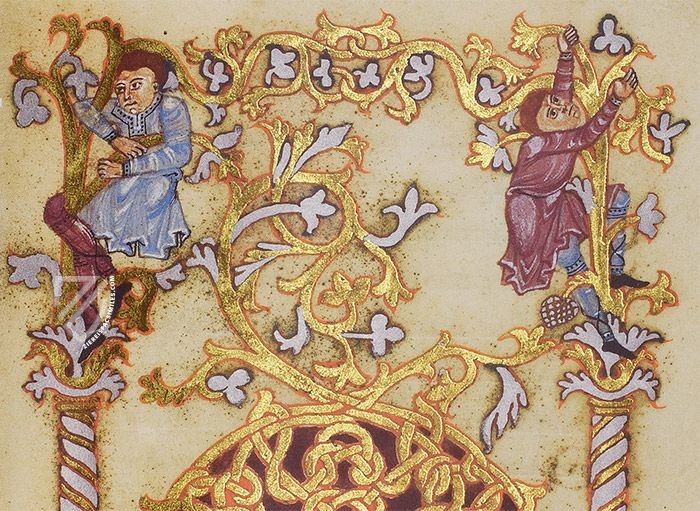
Sacramentary of Beauvais
Crucifixion – Te Igitur
This extraordinary composition of purple, silver, and gold is attributed to a certain Nivardus of Milan. The cross of this Crucifixion scene forms the opening “T” of the Eucharistic prayer Te igitur. Christ is shown triumphant over death with his eyes wide open: gold dots represent the nails in his feet and hands, but there is no blood and he seems to stand rather than hang.
The figures of the Virgin Mary and St. John the Evangelist flank the cross, each with a hand raised to their respective faces in a gesture of sadness, conveying the human suffering of the event. The image, especially with regard to the attitudes of the Virgin and John, is reminiscent of Crucifixion scenes found in contemporary manuscripts from Lombardy.
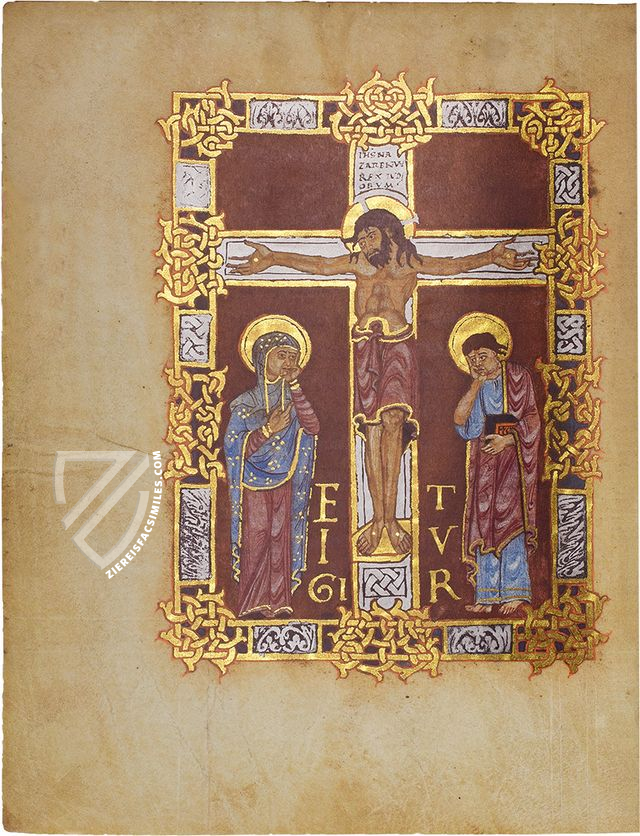
#1 Das Sakramentar von Beauvais (Real Gold Edition)
Languages: German, English
The scientific commentary volume will be written by Dr. Elizabeth C. Teviotdale (Michigan). In it she reveals the origins and history of the manuscript and provides a detailed description of the miniatures, the pages with decorative initials and the entire artistic accoutrements. The commentary volume will be published in English and German.
(1,000€ - 3,000€)
#2 Das Sakramentar von Beauvais (Normal Edition)
Languages: German, English
The scientific commentary volume will be written by Dr. Elizabeth C. Teviotdale (Michigan). In it she reveals the origins and history of the manuscript and provides a detailed description of the miniatures, the pages with decorative initials and the entire artistic accoutrements. The commentary volume will be published in English and German.
(1,000€ - 3,000€)
- Treatises / Secular Books
- Apocalypses / Beatus
- Astronomy / Astrology
- Bestiaries
- Bibles / Gospels
- Chronicles / History / Law
- Geography / Maps
- Saints' Lives
- Islam / Oriental
- Judaism / Hebrew
- Single Leaf Collections
- Leonardo da Vinci
- Literature / Poetry
- Liturgical Manuscripts
- Medicine / Botany / Alchemy
- Music
- Mythology / Prophecies
- Psalters
- Other Religious Books
- Games / Hunting
- Private Devotion Books
- Other Genres
- Afghanistan
- Armenia
- Austria
- Belgium
- Colombia
- Croatia
- Cyprus
- Czech Republic
- Denmark
- Egypt
- Ethiopia
- France
- Germany
- Greece
- Hungary
- India
- Iran
- Iraq
- Israel
- Italy
- Japan
- Lebanon
- Luxembourg
- Mexico
- Morocco
- Netherlands
- Palestine
- Peru
- Poland
- Portugal
- Russia
- Serbia
- Spain
- Sri Lanka
- Sweden
- Switzerland
- Syria
- Turkey
- Ukraine
- United Kingdom
- United States
- Uzbekistan
- Aboca Museum
- Ajuntament de Valencia
- Akademie Verlag
- Akademische Druck- u. Verlagsanstalt (ADEVA)
- Aldo Ausilio Editore - Bottega d’Erasmo
- Alecto Historical Editions
- Alkuin Verlag
- Almqvist & Wiksell
- Amilcare Pizzi
- Andreas & Andreas Verlagsbuchhandlung
- Archa 90
- Archiv Verlag
- Archivi Edizioni
- Arnold Verlag
- ARS
- Ars Magna
- ArtCodex
- AyN Ediciones
- Azimuth Editions
- Badenia Verlag
- Bärenreiter-Verlag
- Belser Verlag
- Belser Verlag / WK Wertkontor
- Benziger Verlag
- Bernardinum Wydawnictwo
- BiblioGemma
- Biblioteca Apostolica Vaticana (Vaticanstadt, Vaticanstadt)
- Bibliotheca Palatina Faksimile Verlag
- Bibliotheca Rara
- Boydell & Brewer
- Bramante Edizioni
- Bredius Genootschap
- Brepols Publishers
- British Library
- C. Weckesser
- Caixa Catalunya
- Canesi
- CAPSA, Ars Scriptoria
- Caratzas Brothers, Publishers
- Carus Verlag
- Casamassima Libri
- Chavane Verlag
- Christian Brandstätter Verlag
- Circulo Cientifico
- Club Bibliófilo Versol
- Club du Livre
- CM Editores
- Collegium Graphicum
- Collezione Apocrifa Da Vinci
- Comissão Nacional para as Comemorações dos Descobrimentos Portugueses
- Coron Verlag
- Corvina
- CTHS
- D. S. Brewer
- Damon
- De Agostini/UTET
- De Nederlandsche Boekhandel
- De Schutter
- Deuschle & Stemmle
- Deutscher Verlag für Kunstwissenschaft
- DIAMM
- Droz
- E. Schreiber Graphische Kunstanstalten
- Ediciones Boreal
- Ediciones Grial
- Ediclube
- Edições Inapa
- Edilan
- Editalia
- Edition Deuschle
- Edition Georg Popp
- Edition Leipzig
- Edition Libri Illustri
- Editiones Reales Sitios S. L.
- Éditions de l'Oiseau Lyre
- Editions Medicina Rara
- Editorial Casariego
- Editorial Mintzoa
- Editrice Antenore
- Editrice Velar
- Edizioni Edison
- Egeria, S.L.
- Eikon Editores
- Electa
- Emery Walker Limited
- Enciclopèdia Catalana
- Eos-Verlag
- Ephesus Publishing
- Ernst Battenberg
- Eugrammia Press
- Extraordinary Editions
- Fackelverlag
- Facsimila Art & Edition
- Facsimile Editions Ltd.
- Facsimilia Art & Edition Ebert KG
- Faksimile Verlag
- Feuermann Verlag
- Folger Shakespeare Library
- Franco Cosimo Panini Editore
- Friedrich Wittig Verlag
- Fundación Hullera Vasco-Leonesa
- G. Braziller
- Gabriele Mazzotta Editore
- Gebr. Mann Verlag
- Gesellschaft für graphische Industrie
- Getty Research Institute
- Giovanni Domenico de Rossi
- Giunti Editore
- Graffiti
- Grafica European Center of Fine Arts
- Guido Pressler
- Guillermo Blazquez
- Gustav Kiepenheuer
- H. N. Abrams
- Harrassowitz
- Helikon
- Hendrickson Publishers
- Henning Oppermann
- Herder Verlag
- Hes & De Graaf Publishers
- Hoepli
- Holbein-Verlag
- Hortus Deliciarum
- Houghton Library
- Hugo Schmidt Verlag
- Idion Verlag
- Il Bulino, edizioni d'arte
- ILte
- Imago
- Insel Verlag
- Instituto Nacional de Antropología e Historia
- Istituto dell'Enciclopedia Italiana - Treccani
- Istituto Ellenico di Studi Bizantini e Postbizantini
- Istituto Geografico De Agostini
- Istituto Poligrafico e Zecca dello Stato
- Italarte Art Establishments
- J. Thorbecke
- Jan Thorbecke Verlag
- Johnson Reprint Corporation
- Josef Stocker
- Josef Stocker-Schmid
- Jugoslavija
- Karl W. Hiersemann
- Kasper Straube
- Kaydeda Ediciones
- Kindler Verlag / Coron Verlag
- Kodansha International Ltd.
- Konrad Kölbl Verlag
- Kurt Wolff Verlag
- La Liberia dello Stato
- La Linea Editrice
- La Meta Editore
- Lambert Schneider
- Landeskreditbank Baden-Württemberg
- Leo S. Olschki
- Les Incunables
- Library of Congress
- Libreria Musicale Italiana
- Lichtdruck
- Lito Immagine Editore
- Lumen Artis
- Lund Humphries
- M. Moleiro Editor
- Maison des Sciences de l'homme et de la société de Poitiers
- Manuscriptum
- Martinus Nijhoff
- Maruzen-Yushodo Co. Ltd.
- MASA
- McGraw-Hill
- Militos
- Millennium Liber
- Müller & Schindler
- Nahar and Steimatzky
- National Library of Wales
- Neri Pozza
- Nova Charta
- Oceanum Verlag
- Odeon
- Orbis Mediaevalis
- Orbis Pictus
- Österreichische Staatsdruckerei
- Oxford University Press
- Pageant Books
- Parzellers Buchverlag
- Patrimonio Ediciones
- Pattloch Verlag
- PIAF
- Pieper Verlag
- Plon-Nourrit et cie
- Prestel Verlag
- Princeton University Press
- Prisma Verlag
- Priuli & Verlucca, editori
- Pro Sport Verlag
- Propyläen Verlag
- Pytheas Books
- Quaternio Verlag Luzern
- Reales Sitios
- Recht-Verlag
- Reichert Verlag
- Reichsdruckerei
- Riehn & Reusch
- Roberto Vattori Editore
- Rosenkilde and Bagger
- Roxburghe Club
- Salerno Editrice
- Sarajevo Svjetlost
- Schöck ArtPrint Kft.
- Scolar Press
- Scrinium
- Scripta Maneant
- Scriptorium
- Siloé, arte y bibliofilia
- SISMEL - Edizioni del Galluzzo
- Sociedad Mexicana de Antropología
- Société des Bibliophiles & Iconophiles de Belgique
- Soncin Publishing
- Sorli Ediciones
- Stainer and Bell
- Studer
- Styria Verlag
- Sumptibus Pragopress
- Szegedi Tudomànyegyetem
- Taberna Libraria
- Tarshish Books
- Taschen
- Tempus Libri
- Testimonio Compañía Editorial
- Thames and Hudson
- The Clear Vue Publishing Partnership Limited
- The Facsimile Codex
- The Folio Society
- The Marquess of Normanby
- The Richard III and Yorkist History Trust
- Tip.Le.Co
- TouchArt
- TREC Publishing House
- TRI Publishing Co.
- Trident Editore
- Typis Regiae Officinae Polygraphicae
- Union Verlag Berlin
- Universidad de Granada
- University of California Press
- University of Chicago Press
- Urs Graf
- Vallecchi
- Van Wijnen
- VCH, Acta Humaniora
- VDI Verlag
- VEB Deutscher Verlag für Musik
- Verlag Anton Pustet / Andreas Verlag
- Verlag Bibliophile Drucke Josef Stocker
- Verlag der Münchner Drucke
- Verlag für Regionalgeschichte
- Verlag Styria
- Vicent Garcia Editores
- W. Turnowsky
- Waanders Printers
- Wiener Mechitharisten-Congregation (Wien, Österreich)
- Wissenschaftliche Buchgesellschaft
- Wydawnictwo Dolnoslaskie
- Xuntanza Editorial
- Zakład Narodowy
- Zollikofer AG

